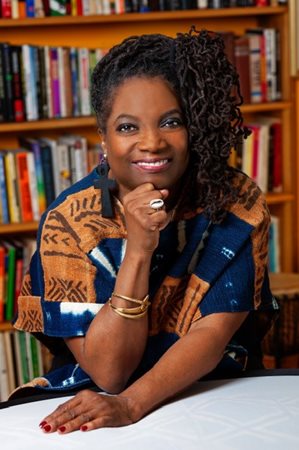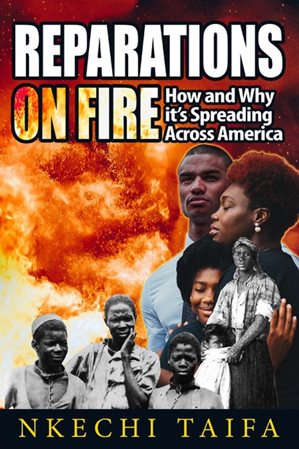Author Chats
In Latest Book, Nkechi Taifa Details How Country Can Move From Racial Reckoning to Reparatory Justice
February 24, 2023
Nkechi Taifa’s Reparations on Fire: How and Why It’s Spreading Across America is a sweeping text. The author recounts the story of the modern reparations movement, often through her own experiences, in a book that rides a line between historical analysis and revolutionary manifesto. Taifa entered the reparations discourse through her youthful engagement with the Black Power movement, and she has been a prominent figure in the discussion ever since.
author recounts the story of the modern reparations movement, often through her own experiences, in a book that rides a line between historical analysis and revolutionary manifesto. Taifa entered the reparations discourse through her youthful engagement with the Black Power movement, and she has been a prominent figure in the discussion ever since.
A D.C. Bar member since 1985, Taifa helped launch the National Coalition of Blacks for Reparations in America (N’COBRA) in 1987 and was an inaugural commissioner of the National African American Reparations Commission (NAARC) in 2015. In 2022 she delivered a TEDx talk titled “Reparations: An Issue Whose Time Has Come” and has written, lectured, and advocated on the topic of reparations across the country. Taifa is founder, principal, and CEO of the social enterprise firm The Taifa Group LLC that works to advance justice.
The D.C. Bar spoke with Taifa about how a once-radical proposition is drawing interest and compelling action across the country today.
As the reparations discourse has expanded from the Black Power movement to the mainstream, what changes have you seen, positive and negative?
Reparations, for good or bad, has become a household word. It’s no longer scary. I mean, it’s still scary to some people, but most are no longer afraid to use the word. People are talking about it openly and there’s actual history-in-the-making going on right now with reparations, whether it’s on the state level with California engaged in historic hearings or at the local level with Evanston, Illinois, leading the way. New York is about to reintroduce reparations legislation, and jurisdictions across the country are establishing commissions and task forces looking at issues in their own backyards and seeking proposals and recommendations for redress.
As for challenges, I would say that Trump-era and post-George Floyd blinders have been taken off of our eyes. People might have been anesthetized during the Obama years, but reality came smack in the face with the next administration. That’s really when we saw an uptick in conversation about reparations, from the 2020 candidates vying for the Democratic nomination to a plethora of organizations embracing the issue.
But the scary thing is that when we look back in history, we see that the more things change, the more they stay the same. When I was first coming into the movement during the late ’60s and early ’70s, Black studies was [entering] classrooms, the mantra was ‘Black is beautiful,’ and everyone was a “brother” and a “sister.” And now, deplorably, Black studies are being taken out of the classrooms. It seems like we are retreating to an earlier era.
As a result, people are seeing the need, the necessity of looking at issues of justice, specifically reparatory justice. Things that you never would have thought of … [that] many people wouldn’t have [thought of] … that this country was built on slavery, [that] it was built on a slaveocracy. We tend to forget about that or don’t realize that fact because the history books don’t reflect it.
There has never been a true accounting of what has happened in this country. It is an absolute shame that it is only now in the 21st century that we have a 1619 Project. Why now, in the 21st century? All of those issues should have been taught from day one.
How has the banning of two earlier texts you authored helped fuel the reparations movement?
All of this anti-this, anti-that, ban this, ban that … it is fueling the movement — the simple act of trying to stop something, trying to suppress something, trying to sweep something under the rug. When you do that, it brings it more out there into the open.
When I found out that my children’s book, Shining Legacy, published in 1983, and my co-authored reparations book, which was published in 1987, were banned by the Central York School District [in Pennsylvania] and weren’t even in print any longer, I said, “Look, I’m going to put them back into print,” and I actually used their banning as a platform when I republished them in 2022. It served as a vehicle for me to be able to talk about them. I wanted my children’s book to be available for a new generation and … I included the original text of [the reparations book] in the appendix to my new book, Reparations on Fire.
I’m the only living survivor of the three authors of that book, which consisted of a set of papers we presented at a 1987 conference on race and the constitution at Harvard Law School, hosted by the National Conference of Black Lawyers.
Those of us who were part of the movement at that time wanted to take the discussion out of the revolutionary fringe and make the issue mainstream. We wanted the sororities and fraternities and the churches and the universities and the civil rights organizations to take up this issue, so we toned down the rhetoric and some of the issues. We didn’t make it a prerequisite that you had to be a revolutionary Black nationalist or a pan-Africanist in order to believe in reparations. It’s about connecting the dots, and that’s part of the reason I decided to include that 1987 Reparations Yes! text in my latest book.
There have been many different reparations proposals over the years and some differences of opinion regarding the form they should take. What are the elements of an effective and appropriate reparations program?
regarding the form they should take. What are the elements of an effective and appropriate reparations program?
Early on, before there was an international standard, I cobbled together what I call the four elements of reparations. First of all, the formal acknowledgement that there was a historic wrong and an unfettered apology. I always say unfettered because there was an apology by the House of Representatives and the Senate, but the Senate apology had a proviso that said you can’t use our apology to justify any claim for reparations … So, the first element is for there to be an acknowledgment that there was a wrong and an unfettered apology.
Second, there needs to be recognition that there was an injury, and that the injury continues, down through to today. Third, there needs to be a commitment to redress from the culpable entities, and finally, the actual redress or compensation in whatever form or forms are agreed upon.
My philosophy about the reparations movement has matured over the years. Back in the day, as a teenager I would joke, ‘Where’s my check,’ but as the years went on I realized that reparations is about more than a check. My mantra now is that the harms from the enslavement period and beyond were multifaceted, thus the remedies must be multifaceted as well. And the remedy is a settlement, a negotiated settlement, because no amount of material benefits can ever compensate for what was done to our people. No amount.
Compensation is a complicated question. In the law, compensation is typically calculated according to the injuries experienced by the wronged party. What injuries would reparations compensate for?
The injuries or harms are not limited to the enslavement era, but also for lingering impacts that still manifest today. There were illegal kidnappings, cultural assaults, forced free labor, and terrorism, followed by convict leased labor, Black codes, sharecropping, peonage, lynchings, mass murders, Jim Crow, gerrymandering, redlining, educational inequities, health disparities, and mass incarceration. Again, the harms were multifaceted; the remedies must be so as well. I’m one person who does believe … that cash payments must be part of reparations, but it’s not the only aspect with regard to remedy.
N’COBRA introduced five injury areas for redress: education, health, the justice system, wealth/poverty, and peoplehood/nationhood. We thought that it was important to note that it was more than stolen labor that was taken from us. Our names, religions, culture — our very right to self-determination — were stolen from us.
We never had the opportunity, even with the 13th Amendment, to determine what our political future was going to be, whether it would be to remain in this country and strive to make a multi-racial democracy real, or have the resources to go somewhere else, or even to establish an independent Black nation-state on this soil. All of those should have been part of a reparations settlement at the close of the Civil War.
What else can be part of a reparations settlement? Land, tax relief, scholarships, repatriation resources, pardon of political prisoners. I’m also a commissioner with NAARC, which has a 10-point program [focusing on] health and wellness, the strengthening of Black America’s information and communications infrastructure, the preserving of Black sacred sites and monuments, and repairing the damages from the “criminal injustice system.”
Indeed, I always feel the need to bring up how there are people still unjustly imprisoned as a result of the Federal Bureau of Investigation’s unjust war against Black people, code-named COINTELPRO, during the 1960s and ’70s. The pardon of these elders, either still imprisoned, in exile, or subject to limiting paroles and probations, could be part of a reparations settlement as well.
I don’t have the answer for this, I’ll be honest, but one thing is that we have to make sure that reparations is more than just equity. I know there are things going on right now with President Biden’s signing of an executive order on equity, but reparations is more than equity. And it is absolutely more than basic public policy that must inure to everybody. So, what is that something extra? I don’t have definitive answers to these questions.
But what I do know is that we are making history right now as the country grapples with these issues. Indeed, there are controversies with respect to what’s happening in Evanston right now. Is it reparations that connects dots to legacies from the enslavement era, or is it a mere housing program? California is sifting through a myriad of issues subsumed within its comprehensive, nearly 500-page interim report that will lead to final recommendations about reparations in the state.
Governments, academic and religious institutions, corporations and industries, and private estates are grappling with these issues now, and brilliant minds must come together to brainstorm viable solutions. A reckoning on reparations is long overdue, but the serious conversation has started, and that thrills me.
Where can readers find your book or learn more about reparations?
For more information visit ReparationEducationProject.org, listen to my TEDx talk on reparations, or purchase my books at AALBC.com or Amazon, including Reparations on Fire; my memoir, Black Power, Black Lawyer; and my children’s books Shining Legacy, The Adventures of Kojo and Ama, and Three Tales of Wisdom.


